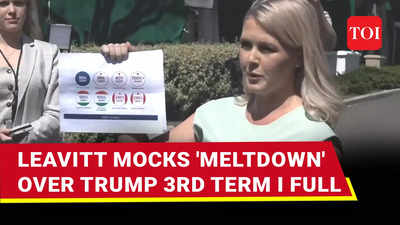US President Trump has mused more than once that he might like to extend his stay at the White House. But can he run for re-election in 2028 and seek a third term? The simple answer: No, the US constitution does not allow it. By the end of his second term, Trump, now 78, would be the oldest president in history. Here’s why the issue has surfaced and what the law says.
Trump has made several comments on third term
President Trump told NBC News on Sunday that he was “not joking” about the possibility of seeking a third presidential term, suggesting in an interview with “Meet the Press” that there were “methods” to circumvent the two-term limit laid out in the constitution. It was the first time that Trump had indicated he was seriously considering the idea.
At the start of his second week back in office, Trump floated the idea that the presidential term limit might be negotiable while speaking to House Republicans during their annual retreat in Florida. On Feb 6, at a breakfast at a Washington hotel, Trump again hinted at the prospect that his time in office could extend beyond two four-year terms. While talking to House Republicans in Nov about clinching the White House and both chambers of Congress, Trump jokingly suggested that they could help prolong his presidency. And during his first term in office, Trump suggested to his supporters at a Sept 2020 rally in Nevada that term limits were not set in stone.
Presidential term limits are enshrined in constitution
The 22nd amendment to the constitution, which was ratified in 1951, says that “no person shall be elected to the office of the president more than twice.” Kimberly Wehle, who teaches constitutional law at the University of Baltimore and wrote a book titled “How to Read the Constitution – and Why,” said that the measure left no ambiguity and was intended to place a check on the president.
Can Trump get around the 22nd amendment?
Amending the constitution to get around the two-term limit would be a very tall order.
Two-thirds majorities in both the House and Senate are required just to propose an amendment, far more than the slender majorities Republicans hold in both chambers now, or two-thirds of the states have to call for a constitutional convention. Ratifying an amendment is even more onerous: Three-fourths of all state legislatures – or of those state-level constitutional conventions – must approve it.
Three days after Trump was sworn in to a second term, one of his allies in the House, Representative Andy Ogles, a Republican of Tennessee, introduced a long-shot resolution to amend the constitution to provide him with a pathway to a third term.
The part of the resolution applying to Trump is worded this way: “No person shall be elected to the office of the president more than three times, nor be elected to any additional term after being elected to two consecutive terms.” Ogles argued that Trump needed more time to accomplish his agenda.
Is Trump really not joking?
Representative Dan Goldman, Democrat of New York, hasn’t treated Trump’s previous quips about staying in office as a laughing matter. Soon after Trump remarked in Nov that House Republicans could help pave his way to a third term, Goldman introduced a resolution to reaffirm that the 22nd amendment applies to presidents who serve non-consecutive terms. He reintroduced the measure in Feb in response to the move by Ogles.
Has a president ever served more than two terms?
Yes. Franklin D Roosevelt was elected to four terms, serving from 1933 to 1945, during the Great Depression and WWII. He died while in office. There was no 22nd amendment then, but Roosevelt’s grip on power became a driving force for setting term limits for presidents. nyt




